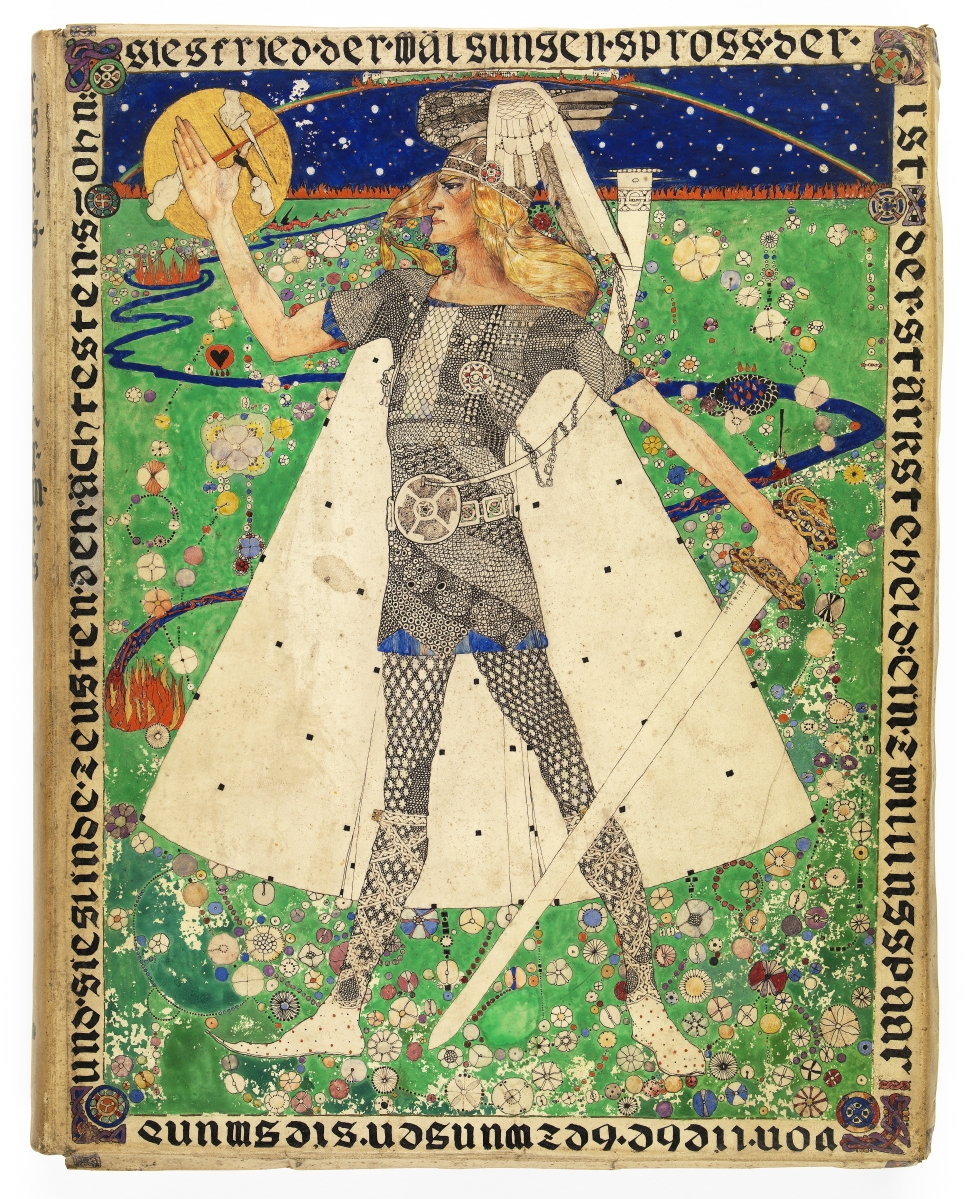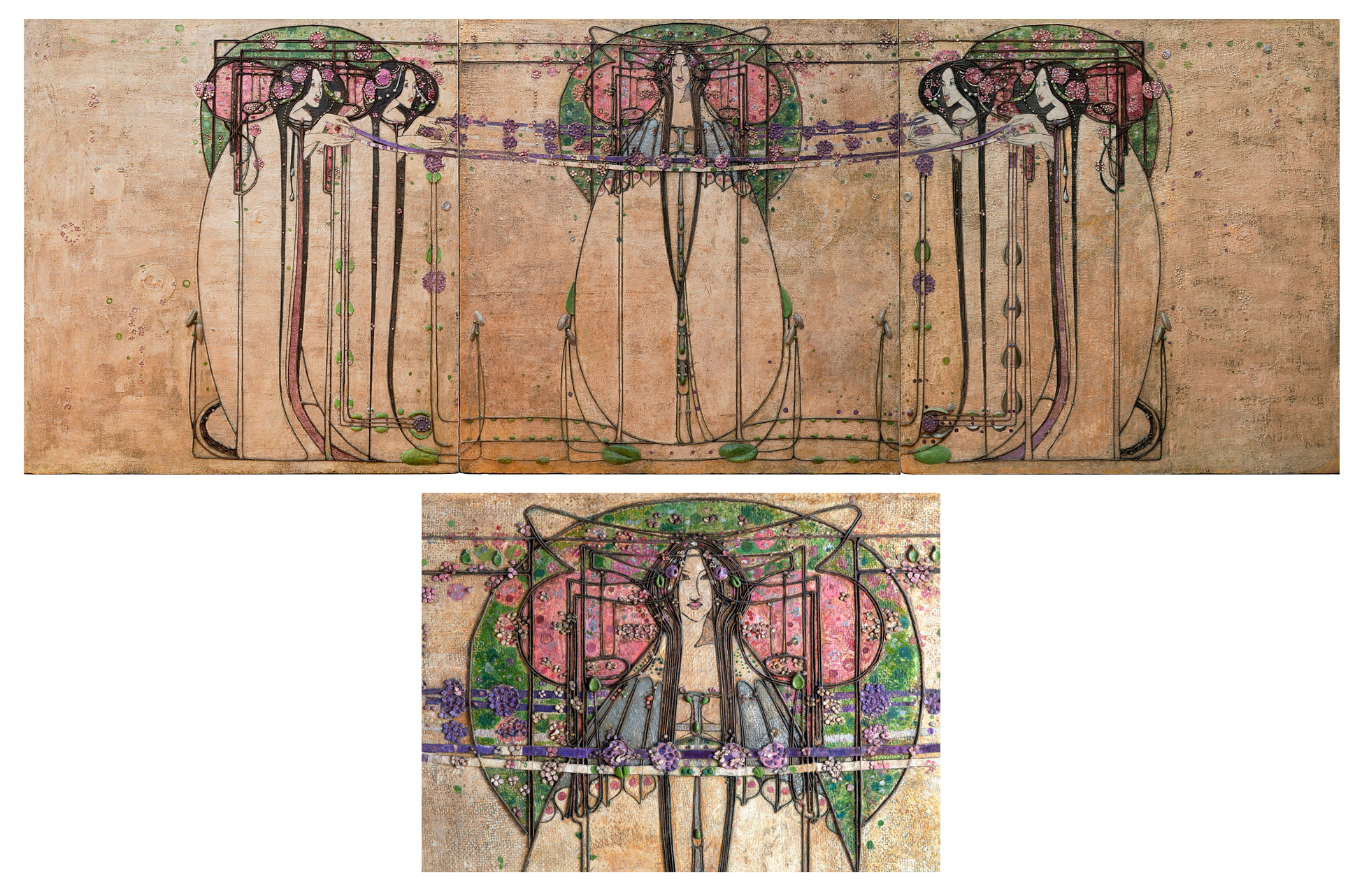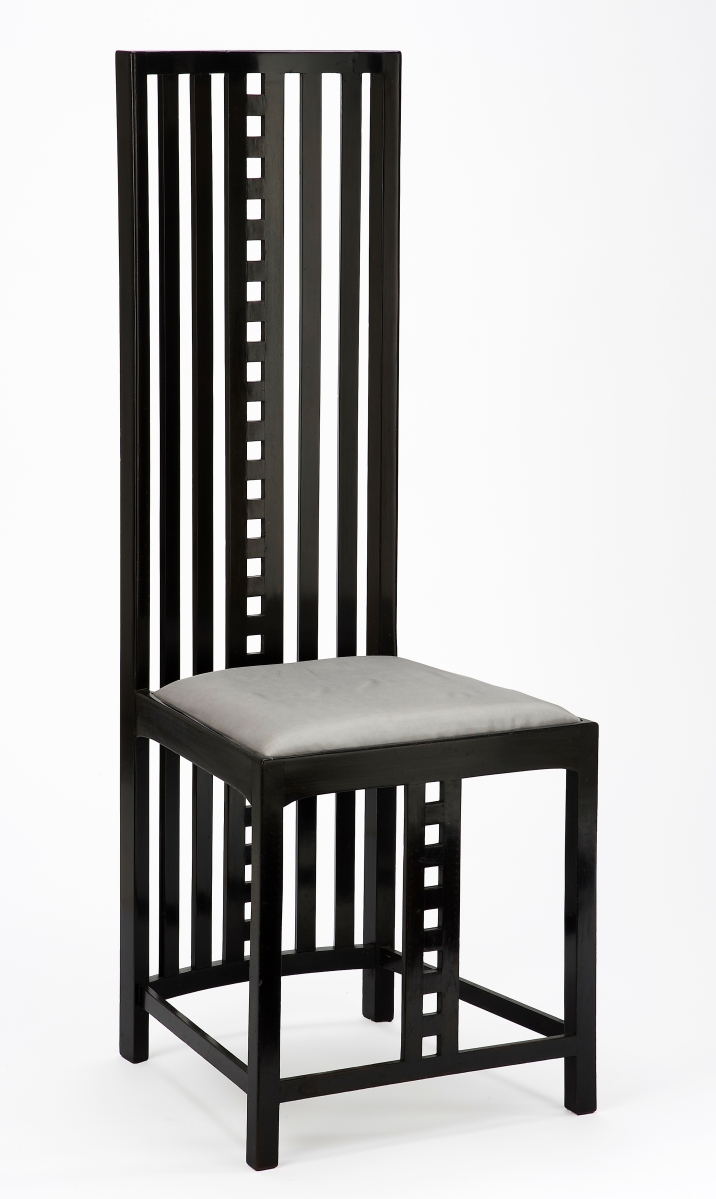
“Score for Gotterdammerung” by Dorothy Carleton Smyth (designer and maker) and Richard Wagner (composer), circa 1898 or after. Card, paper, ink and printed paper. ©CSG CIC Glasgow Museums Collection, presented by the artist’s family, 1943. Courtesy American Federation of Arts.
By Karla Klein Albertson
NASHVILLE, TENN. – In recent centuries, few creative individuals have possessed the range of artistry displayed by Charles Rennie Mackintosh (1868-1928), a man equally adept at architecture, interior design and painting. When Americans wanted to see his best work in the decades after his death, they would take energetic study trips to his home city of Glasgow where he worked with his close associates. Then 25 years ago, the Glasgow Museums sent over a major exhibition that hopped across the continent from New York to Chicago to Los Angeles, and collectors still reach for the 1996-1997 “Charles Rennie Mackintosh” show catalog on the reference shelf.
But, at last, “Designing the New: Charles Rennie Mackintosh and the Glasgow Style” – a fresh take on the artist – will open June 12 for a three-month run at the Frist Art Museum in Nashville. The exhibition, organized by the Glasgow Museums in conjunction with the American Federation of Arts, will display 165 artifacts from public and private collections that demonstrate the artistic output of Mackintosh as well as his closest associates. In addition to actual architectural drawings, furniture, posters, ceramics, textiles, books and paintings, there will be video tours of the actual buildings in Scotland.
The Frist – an impressive structure in the city’s vibrant downtown – is a familiar sight to antique dealers and collectors who gather in Nashville for the spring shows. Now celebrating its 20th anniversary, the museum occupies the city’s magnificent Art Deco main post office, which opened in 1934. When it was repurposed, the goal was to attract high quality exhibitions, a goal that has been consistently fulfilled. “Mackintosh” follows the wildly popular “Picasso Figures” earlier this year and will be succeeded by the perfect fit “American Art Deco: Designing for the People 1918-1939” later in 2021.

“The May Queen” by Margaret Macdonald Mackintosh, panel from the Ladies’ Luncheon Room, Ingram Street Tea Rooms, 1900. Gesso, hessian, scrim, twine, glass beads, thread, mother-ofpearl and tin leaf. Glasgow Museums, acquired by Glasgow Corporation, as part of the Ingram Street Tearooms, 1950. © CSG CIC Glasgow Museums Collection. Courtesy American Federation of Arts.
Antiques and The Arts Weekly talked with Trinita Kennedy, the museum’s senior curator, about how this exhibition traveled from Scotland to Tennessee: “We knew someone who was working with Glasgow at the time to bring this exhibition to the United States. Over the years we’ve worked periodically with the American Federation of Arts, we had that connection already. We were discussing possible future opportunities, and this came up as something they were working on.”
“Our mission at the Frist is to show the art of the world. We did jump on this exhibition right away, because there are so few works by Mackintosh in the United States. We’ve never had the opportunity to show his work at the Frist even though we’ve done quite a few Art Nouveau exhibitions over the years. In the past, we did a show called ‘Paris 1900’ and another about japonisme called ‘Looking East,’ but we’ve never had Mackintosh before. Most of his work does remain in Glasgow, and even the Metropolitan Museum of Art only has half a dozen things.”
She pointed out, “This exhibition is ground-breaking because it shows that Mackintosh wasn’t an isolated genius – it really does examine his entire circle, looking more at a lot of the women artists who were working in Glasgow at the time. The New York exhibition focused almost exclusively on Mackintosh. There were a few works by other artists, but it really was about him. Here, you learn more about Margaret Macdonald, his wife, Frances Macdonald, her sister, and Herbert McNair, her sister’s husband. But then there are other figures who are going to be entirely new to people in America such as Jessie Marion King, who was a successful book designer and graphic artist. And there’s material on Talwin Morris who was also a book designer in Glasgow at the time and was very close to Mackintosh. Many of these figures taught at the Glasgow School of Art.”
.jpg)
Light fitting for the Ingram Street Tea Rooms by Charles Rennie Mackintosh (designer), 1900. Copper, aluminum and leaded glass. Glasgow Museums, acquired by Glasgow Corporation, as part of the Ingram Street Tearooms, 1950. ©CSG CIC Glasgow Museums Collection. Courtesy American Federation of Arts.
Kennedy also emphasized that scholarship has advanced over the intervening decades since museumgoers have had a chance to view masses of Mackintosh: “The exhibition really reflects a lot of recent research and brings it all together because there have been multiple scholars in Glasgow over the last 30 years who’ve done work on women artists. Francis Henry Newbery (1855-1946), who was the director of the Glasgow School of Art, deliberately recruited more female students for the school; he thought of women and men as having equal potential to be artists. They really are very progressive in Glasgow at the end of the Nineteenth Century, although there are areas where there is a delay in their participation in certain fields, such as architecture and furniture design.” Although there may not have been women architects, female artists did achieve success in painting, pottery decoration, metalworking and graphic design.
Although it might be hard to select one work from so many outstanding exhibits, the curator admitted a favorite might be “The May Queen,” a monumental panel painted by Margaret Macdonald Mackintosh (1864-1933) for the Ladies’ Luncheon Room, Ingram Street Tea Rooms, in 1900. The 15-foot-wide panel is usually displayed quite high as it was meant to be, but, says Kennedy, “The way we will display it is at eye level so you really get to see how it is made. There is also this wonderful iPad component where you can see details and learn how the frieze was made.” Another use of tech will be videos of Mackintosh architecture, all new for this exhibition, which are projected on a large scale. Some were made using drones so they reveal new angles that have never been seen before. Kennedy added, “I do think that Mackintosh is going to be a revelation to most of our visitors.”
Zooming in from Scotland, Alison Brown, the curator of European decorative art and design from 1800 at the Glasgow Museums, and the actual exhibition organizer, will give an opening lecture on an ever-popular subject: “The Acme of Originality – Charles Rennie Mackintosh’s Cutting-Edge Tearoom Designs.” Brown authored the accompanying exhibition catalog, which brings together all the recent research. The volume shares its title with the exhibition and should not be missed. It is already available from online booksellers at a very reasonable price.

Chair of design for the writing desk for The Hill House, designed by Charles Rennie Mackintosh and made by Alex Martin, 1904-05. Ebonized wood, with modern upholstery. Glasgow Museums, given by Mr W. Sommerville Shanks, RSA, 1940. ©CSG CIC Glasgow Museums Collection. Courtesy American Federation of Arts.
Expanding on the subject of the importance of Mackintosh working within his circle of fellow artists, she titles one chapter: “Collecting Mackintosh and the Glasgow Style: A Story of Friendship, Zeitgeist, and Civic Recognition.” Toward the end she writes, “With their youthful rebellious streaks, their perceived enjoyment of challenging established norms, the individual expression of this through their clothing, their art, and The Four’s androgynous figurative style, one could say that Mackintosh and his friends were the Punks – or the more creatively ‘gender-bending’ post-punk New Romantics – of their day… The starting point I give you is to not think of Mackintosh purely within the intellectual framework of his discipline, not as a removed, isolated, historical figure. The starting point is to think of Mackintosh and all of his friends and broader circle as people living through and contributing to the excitement of progressive, changing, sometimes challenging times.”
Anyone whose interest has been fully aroused by the exhibition and catalog should visit the website of the Charles Rennie Mackintosh Society in Glasgow – crmsociety.com. View history, find more books about the artist, gain access to online talks and tour possibilities, and see notices when works come up on the auction market. The society’s international headquarters are in Mackintosh Queen’s Cross, the only church he designed, which – FYI – is available as a memorable venue for weddings and vow renewals.
The Frist Art Museum is at 919 Broadway. For more information, www.fristartmuseum.org or 615-244-3340.







.jpg)

.jpg)





